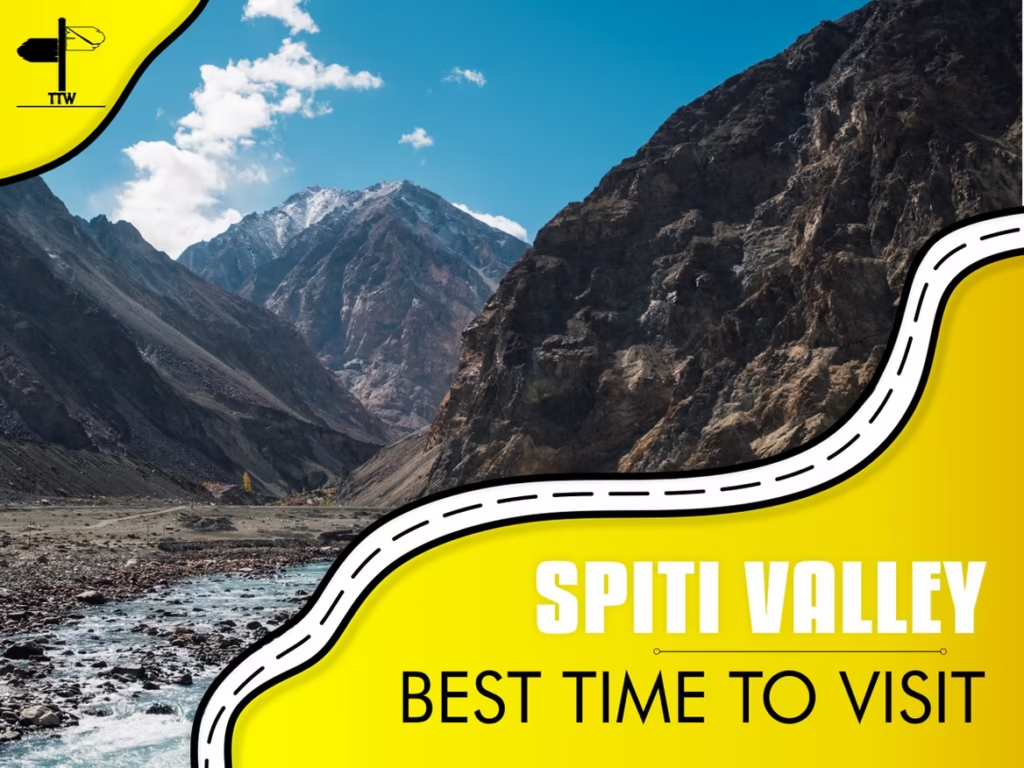Spiti Valley: The Best Travel Guide to Finding the Right Time to Go

Some places on Earth are more than just places to go; they are trips to another world. One of these places is the Spiti Valley. This cold desert mountain valley is a piece of Tibet that has been cut off from the rest of India. It is in the far north-east of Himachal Pradesh. It’s a place of stark, breathtaking beauty, with ancient monasteries clinging to bare cliffs, clear blue rivers cutting through huge canyons, and a billion stars lighting up the night sky. If you’re not brave, you shouldn’t go to Spiti. The roads are hard to drive on, the altitude is hard to deal with, and the weather is bad. But for those who answer its call, the rewards are beyond measure. It’s an adventure that pushes you to your limits, a spiritual journey that calms your soul, and a cultural experience that opens your heart. The friendly people who live here, who have simple lives and warm smiles, are what make this valley special. Timing is the most important thing for a successful trip to the Spiti Valley. Picking the best time to visit Spiti Valley can make the difference between a great trip and a logistical nightmare. The weather here is very bad, and the high mountain passes that connect the two areas are only open for a few months each year. This is the most complete guide to planning the best trip to Spiti Valley. We’ll talk about everything, from the best time of year for your travel style to detailed itineraries, what to pack, how to budget, and all the things you need to do (and not do!). We have something for everyone, whether you’re looking for adventure, spirituality, or photography. A World Within a World: About Spiti Valley Credit: unsplash The name “Spiti” means “The Middle Land,” which is a perfect way to describe where it is between India and Tibet. It’s a cold desert at a high altitude, which means it doesn’t get much rain because the Himalayas block the monsoon clouds. This makes the area’s famous landscape: rocky, barren mountains in shades of brown, purple, and grey, with patches of green barley fields and the Spiti River’s shimmering turquoise. Tibetan Buddhism is the main religion in this area. There are some of the oldest and most important monasteries in the world in the valley. For more than a thousand years, there have been places where people can learn and grow spiritually. Life here is simple, hard, and very connected to nature and faith. A full breakdown of the best times to visit Spiti Valley by season Credit: freepik.com There isn’t one “best” time to visit Spiti; it all depends on what you want to do. The valley has a very different personality in each season. The best time to go is in the summer, from June to September This is the best time to visit Spiti Valley because it is the most popular and easiest to get to. The weather is perfect, and the whole Spiti circuit, even the high passes, is open. Weather: The temperature during the day is nice and warm, between 15°C and 25°C. A t-shirt and a light jacket are often enough to keep you warm. But the nights are still cold, with temperatures dropping to between 3°C and 7°C. Road Conditions: The highways from Manali to Kaza and from Shimla to Kaza are both open. There may be some water crossings from melting snow and occasional landslides caused by the monsoon on the roads leading up to the area (especially near Manali), but this is usually the safest time to go on a road trip. What to Look Forward To: Bright Landscapes: The valley is at its greenest right now, with lush barley fields making beautiful patches of colour against the dry mountains. Access: It’s easy to get to all of the monasteries, villages, and tourist spots, like the famous Chandratal Lake. Peak Crowds: This is the most crowded time of year, especially in June and July when Indian schools are out for summer break. There will be more tourists, and rooms can fill up quickly. Who Should Go in the Summer? This time of year is great for first-time visitors, families, and people who like the weather to be more pleasant. This is the best time to see and do everything the valley has to offer. Fall (from mid-September to October) is the best time for photographers Credit: freepik.com A lot of people who have been to Spiti Valley before say that this is the best time to go. The summer crowds are gone, the monsoon has passed, and the valley is now bathed in a magical golden light. The weather is nice and clear, with temperatures between 10°C and 20°C. But the nights get a lot colder, and they often go below freezing (0°C to -5°C). Road Conditions: The roads are mostly in great shape now that the monsoon rains have stopped. But there is a small but real chance that the Kunzum Pass (on the Manali route) will close after the first week of October due to an early snowfall. What You Should Expect: The valley turns into a canvas of fall colours that are stunning. After the harvest, the poplar and willow trees turn a bright yellow, and the fields turn a golden brown. Fewer Tourists: You’ll have the beautiful scenery and old monasteries all to yourself. Clear Skies: The air after the monsoon is very clear, giving you the best views of the snow-covered peaks and the stars at night. Who Should Come in the Fall? This time of year is great for photographers, people looking for peace, and experienced travellers who don’t mind the cold and want to see the valley at its most beautiful and peaceful. Winter (November to April) is the best time for an adventure Credit: pexels.com Not everyone can go to Spiti in the winter. It is a very extreme adventure that needs a lot
10 Rural Tourism Experiences in India to Reconnect Roots

Slow travel provides that.” In an increasingly time-stretched world, ever more travellers are seeking such valuable and authentic experiences. That is precisely the reason why rural tourism in India is becoming hugely popular. It provides the opportunity to get in touch with the soul of India — its villages — where tradition, culture, and nature coexist in perfect harmony. There’s no better way to explore rural Via with its beautiful scenery, fresh food, and long-held traditions. Since more than 60% of Indians live in villages, rural tourism provides a peek into a lifestyle that is simple and sustainable. More than personal fulfilment, such travel helps local communities earn a living and protect their culture. If you’re looking for a vacation that is at once restful and purposeful, check out our list of the 10 best experiences rural tourism has to offer in India, where travel truly takes you back to your roots. 1. Kumbalangi Village, Kerala: The Perfect Fishing Village Photo Credit: Onmanorama Kumbalangi is a beautiful island village in the backwaters of Kochi. It was the first place in India to be called a “model tourism village.” The calm backwaters, thick mangrove forests, and green rice fields make it a perfect picture of how people and nature can live in peace. Try these immersive experiences: Go fishing with the local fishermen in the morning. Go for a peaceful canoe ride to see the thick mangrove forests. Find out how to use the well-known Chinese fishing nets. Pro Tip: Stay in a local homestay. The families here are very friendly and will give you the most real taste of life in the backwaters. 2. Khonoma Village in Nagaland, also known as “The Green Village” Photo Credit: Pelevizo Meyase via Instagram India’s first “green village” is Khonoma. People in this village in Nagaland have worked hard to stop hunting and protect their natural forests. The end result is a stunningly beautiful place with rice fields on terraces and hills covered in trees. Try these immersive experiences: Go to a local farm and learn how to terrace farm in a unique way. Go on a guided nature walk through the forest that the community protects. Over a cup of locally made rice beer, tell stories and get to know the villagers. Pro Tip: Khonoma is a great place to watch birds. Bring binoculars because there are many rare and beautiful birds in the forests here. 3. Ladhpura Khas, Madhya Pradesh: The Village Where Food Comes From Photo Credit: mptourism This little village near Orchha is a great example of how to live in a way that doesn’t hurt the environment. “Farm to Plate” is the village’s motto, and it means that guests eat meals made with fresh vegetables and grains grown on the village farms. Things to try that are immersive: Learn about organic farming from the people who live there by helping out in the fields. Enjoy Bundelkhandi food that is made in the traditional way and tastes great. Join in on the village’s efforts to keep their culture alive by going to local festivals. Pro Tip: The UNWTO nominated this village for the Best World Tourism Village award. People in the area are very proud of this achievement and would be happy to tell you about it. 4. Kongthong Village, Meghalaya: The Whistling Village Photo Credit: Newsbytes Kongthong is a village in the East Khasi Hills of Meghalaya that has a tradition that is truly one-of-a-kind. People here don’t just call each other by their names; they also have a special song for each person. A mother will whistle a special tune to call her child instead of yelling their name. Try these immersive experiences: Just walk through the village and listen to the lovely sounds of people whistling to each other. Ask someone from the area to show you how to sing their name. Hike through the beautiful green hills that surround the village. Pro Tip: This is a very quiet place. It’s a great opportunity to switch off your phone, sit back, and just listen to the unique “language” of the village. 5. Pochampally, Telangana: The Village of Weavers Photo Credit: ntnews.com Pochampally is close to Hyderabad and is known for its beautiful silk sarees, which have unique tie-and-dye patterns called “Ikat.” The UNWTO has named the village one of the Best Tourism Villages because of its amazing weaving. Things to try that will really get you involved: Go to a weaving unit to see how the colorful sarees are made, from dyeing the threads to putting them together. Take a walk through the village and watch the weavers work on looms in their own homes. Buy beautiful sarees, bedsheets, and other handwoven fabrics right from the people who make them. Pro Tip: Don’t be afraid to talk to the weavers. They are usually happy to talk about the history and the complicated process behind their traditional designs. 6. Turtuk Village, Ladakh: The Last Village in Baltistan Photo Credit: Ladakhtourism.net Turtuk was in Pakistan-occupied Baltistan until 1971. It is on the banks of the Shyok River. It is now one of the most beautiful and remote villages in Ladakh that you can visit. This place has a culture that is a unique mix of Tibetan and Persian. Immersive Experiences to Try: Walk through the village’s narrow cobblestone alleys and admire the traditional stone houses. Take a trip with a local farmer to see the green barley fields and apricot orchards. Find out about the Balti culture, which is very different from the rest of Ladakh. Pro Tip: Try the local food, especially dishes made from apricots and buckwheat. People say that the apricots grown here are some of the sweetest in the world. 7. Grahan Village, Himachal Pradesh: The Secret Treasure of Parvati Valley Photo Credit: Adventure Nation For those who love trekking, Grahan village near Kasol is a perfect offbeat destination. The only way to reach this beautiful village is by a scenic 4-5 hour trek.
How to Travel Comfortably in India on a Budget: 10 Essential Tips

India is a magical place that always leaves travelers speechless, no matter what time of year it is. There is always something amazing to find, from the high Himalayas to the sunny beaches in the south. A lot of people want to go on a fancy trip, but we usually have to travel on a tight budget. But does traveling on a budget have to mean being uncomfortable? No way! It’s not about how much you spend on a trip, but how you spend it that matters. You can have a great and comfortable vacation in India without spending a lot of money if you make a few smart choices. The key is to travel smarter, not cheaper. There is no one “budget” that works for everyone, but these tips can help anyone save money and still have a great time. “Here are 10 important tips to help you plan the perfect trip to India so you can enjoy your time there while staying within your budget.” 1. Stay in guesthouses and homestays Image by Business Traveller Stay in an Airbnb, a homestay, or a guesthouse run by a local family instead of a pricey hotel. These places are much cheaper and more comfortable than hotels, and they give you a better taste of Indian culture. How This Helps You Save Money: Most of the time, nightly rates are much lower than hotel rates. Many homestays let you use the kitchen, so you can make some of your own meals. Your local host will give you free, useful tips on where to eat and what to do. Pro Tip: Before you book, make sure to read the reviews carefully. Check out places that talk about how clean they are and how nice the host is. A good host can make your trip a lot more fun. 2. Go on vacation when it’s not busy Image by Tour My India One of the best ways to save money is to not travel during busy times like major holidays (Christmas, Diwali) or school breaks (May to June). Everything, from flights to hotels, is a lot cheaper when you travel during the off-season. How This Saves You Money: Flights and hotels can be 30 to 50 percent less expensive than at peak times. There will be fewer people at popular tourist spots. Because there is less demand, local shops and taxis may have better prices. Pro Tip: The “shoulder seasons,” which are the months just before or after the peak season (like September or March), are usually the best times to go because the weather is nice and the prices are low. 3. Eat Smart Like a Local Image by Alex Green If you know where to look, food in India can be very cheap and tasty. It’s nice to go to a nice restaurant every once in a while, but eating out every meal can quickly add up. Eating like the locals is the most important thing. How This Saves You Money: Street food and local restaurants (dhabas) serve full, tasty meals for a lot less than tourist-focused restaurants. If you have a kitchen, making your own breakfast or a simple dinner can save you a lot of money. Buying fresh fruit from local markets is a cheap and healthy way to snack. Pro Tip: To find the best and safest street food, look for stalls that are busy with people from the area. The food is fresh because a lot of people come and go. 4. Get good at haggling In many local markets in India, it’s normal to haggle over prices. The first price you are given for things like clothes, souvenirs, and handicrafts is usually higher than the real price. You shouldn’t be afraid to politely bargain. How This Saves You Money: If you haggle, you can often get 20–30% off the original price. It stops tourists from being charged too much. Pro Tip: When you go to a street market or get into an auto-rickshaw (if there’s no meter), you should be ready to haggle. But in restaurants, branded stores, and hotels where prices are set, you shouldn’t haggle. Always smile when you haggle! 5. Take public transportation The public transportation system in India is very big and works well. It’s also the cheapest way to get from one city to another. Instead of paying for expensive flights or private taxis for every trip, use the local way to get around. How This Saves You Money: Tickets for trains are a lot cheaper than tickets for planes, especially for long distances. The cheapest way to get around a city or to nearby towns is by taking the bus. The metro in cities like Delhi, Mumbai, and Bangalore is cheap, quick, and has air conditioning. Pro Tip: Indian Railways is the best way to travel long distances. Use the official IRCTC website or apps like RailYatri to buy your tickets ahead of time. 6. Go on a trip overnight This is a classic backpacking tip that will save you a lot of money. If you need to travel a long way, book a bus or train for the night. You’ll wake up in a different city, which will save you time and money. How This Will Help You Save Money: You don’t have to pay for one night in a hotel or guesthouse. You don’t waste a whole day of your vacation just getting there. Pro Tip: For a comfortable, safe, and air-conditioned overnight trip, book a sleeper class in AC 3-Tier (3A) or AC 2-Tier (2A) on trains. 7. Visit places that aren’t very popular Jaipur and Goa, two popular tourist spots, can be expensive. If you want to save money and have a more unique experience, think about going to places that aren’t as well-known. These places are usually cheaper and give you a more real look at how people live there. How This Will Save You Money: In places that aren’t touristy, food and lodging
Top Dubai Tours: Perfect for Groups & Solo Travelers

Dubai is full of contrasts — huge skyscrapers next to golden deserts; fancy resorts next to traditional bustling souks; and, on every corner, stories to uncover. Dubai has something for every traveler whether you’re traveling alone, with friends, or in a group. From adrenaline-charged activities to cultural explorations. Here is your guide to the best Dubai tours to help share ideas for your ideal trip. Planning a Dubai tour may seem overwhelming – there are so many options! The Tarzan Way has you covered. Tour itineraries designed by the experts help travelers narrow down experiences based on preferences, group size, and time pace so you can focus on memories without stress. Why Choose Dubai Tours? Exploring Dubai is more than basic sightseeing – it’s about experiencing the city more thoughtfully. Here are reasons why it’s a good idea to participate in a guided tour or follow a set itinerary: Local Knowledge: If you’re going to go on a guided tour, the tour guide is likely going to know the perfect times to see the best spots, where the hidden gem locations are. Convenience for Groups: Coordinated transport(relieving the burden of car rentals and taxis), entrance tickets, and tour guides make for a relaxing experience for all. Comfort Factor for Solo Travelers: Small group tours offer a perfect place to meet other like-minded travelers while also keeping it safe. Unique Experiences: Sometimes, a tour can include desert activities like safaris or cultural walks that can add a lot to your visit and show what to do in the tour besides dune bashing. If you like finding ways to get off the beaten path during travel, there’s a great blog about Dubai Desert Safaris – Offbeat and Unique Experiences You Can’t Miss that shares unique ideas on things to do in the desert instead of dune bashing that you’ll never forget! Top Dubai Tours for Group Travelers 1. Desert Safari Adventure A desert safari is a must-do while in Dubai — be it just a half-day ride or possibly an overnight camp, the desert is where adventure meets culture. What will you be doing: dune bashing, camel rides, standard sandboarding, and BBQ dinners under the stars, punctuated by traditional music. Pro Tip: Make sure you book for an evening — you’ll catch the dunes glowing from the sunset, and the temperature is cooler in the evening. For travelers looking for offbeat and unique experiences, combining the desert adventure with small cultural insights can be truly magical. You can even read Top Free Offbeat Things to Do in Dubai for ideas on quirky spots to explore nearby. 2. Dubai City Tour If you’re visiting the city for the first time, you definitely want to join a guided city tour. You will see all of the major sites without the stress of figuring things out based on transportation. Highlights of the tour include: Burj Khalifa, Dubai Mall, Dubai Fountain, Jumeirah Mosque, Palm Jumeirah, Atlantis The Palm. Pro Tip: If you choose a morning tour, there are usually fewer crowds. It is perfect to do the tour in the day, and then go back for the evening fountain show. Members also love this type of tour because they combine seeing the sites, and a little flexibility for shopping or photo stops. 3. Abu Dhabi Day Trip A short drive from Dubai will take you to Abu Dhabi, where you can enjoy culture and luxury beyond what Dubai has to offer. As a reminder, Abu Dhabi’s highlights include: Sheikh Zayed Grand Mosque, Louvre Abu Dhabi, Ferrari World, and Yas Marina Circuit. Pro Tip: Visiting on a midweek day is quieter and more relaxing. Usually, you can plan the wonder of a day trip to Abu Dhabi alongside your Dubai city tour as part of a larger experience of the UAE together. This arrangement tends to serve well for travelers wanting a modern city and culture. 4. Adventure & Sports Tours Dubai offers plenty for those who seek an adrenaline rush. From sky-diving over Palm Jumeirah, to jet-skiing and flyboarding, there is no shortage of excitement for every type of thrill seeker. Pro Tip: If you are traveling in the high season (Nov-Mar) to Dubai, take the opportunity to book in advance to guarantee time-slots for the best adventures at the best price. Whether you are a solo traveller or part of a group, adventure and sightseeing tours are going to be an especially engaging way to visit Dubai. Don’t forget, if you want to incorporate an ‘off the beaten path’ and experience that is a little more affordable, some experiences shared in this post from Dubai Travel on a Budget – Is It Possible? would compliment a great, fun day. 5. Cultural & Historical Tours Dubai has a rich past, and exploring it can be fascinating. Al Fahidi Historical District, Dubai Museum, Dubai Creek, Gold Souk, Spice Souk are the highlights. Pro Tip: Take a traditional abra ride across Dubai Creek — it’s a peaceful and authentic way to soak in the city’s history. For a more romantic and cultural angle, couples can also check Old Dubai’s Hidden Gems – Cultural Charms for a Romantic Getaway for ideas on scenic walks and historical spots. Best Dubai Tours for Solo Travelers 1. Walking & Food Tours Solo travelers love walking and food tours — they’re social, easy, and authentic. Highlights: Try shawarma, luqaimat, camel milk ice cream, and explore lively neighborhoods. Pro Tip: Evening tours combine food sampling with cultural insights — a great way to meet people. 2. Art & Photography Tours Dubai’s public art, skyscrapers, and street murals make it a photographer’s paradise. Highlights: Alserkal Avenue, Dubai Opera, colorful murals, futuristic architecture. Pro Tip: Early morning light is ideal for capturing the best photos. For solo travelers looking for creative inspiration, there’s a helpful guide on Dubai Dreams – Honeymoon Adventures Unveiled that also includes visual spots perfect for photography. 3. Wellness & Spa Tours Relaxation is also part of the solo travel experience



